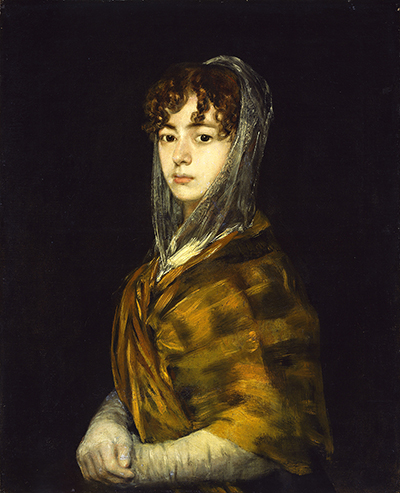Created between 1806 and 1811, this unique portrait is now permanently housed in the National Gallery of Art in Washington. The dimensions are 78 x 51 cm.
The subject, Señora Sabasa García lives on through time. Her pale skin and curly dark blonde hair reveal a young woman who is self-confident but a little vulnerable. Her youth and apparent innocence are attractive and draw out the protective instincts of those who view the portrait. This is actually considered to be one of Goya's finest portraits. He doesn't show any setting or background. The subject is the sole focus of the portrait. It was created over a period of five years, so the setting may have changed over time. However, we get the impression that the artist is despensing with details and focussing on the lady's lustrous eyes and extreme youthfulness. The details of her mantilla are not shown, just a gauzy, transparent impression.
Her dewy, youthful complexion, large eyes and innocent-looking curls are the focus, as is her greenish-gold shawl. Señora Sabasa García by Francisco de Goya is a picture of innocence, youth and vulnerability. This lady was a well-connected Spanish woman with a distinguished background. Her real name was María Garcia Pérez de Castro, known as Sabasa to all in a country where the name María was very common. Her uncle was Spain's Minister for Foreign Affairs, Evaristo Pérez de Castro. Legend has it that Goya met the young woman on a visit to her uncle's house. He was so struck by her beauty that he asked for permission to paint her.
An artist of the Romantic tradition in the late 18th century and early 19th century, Goya had a long, fascinating life. He grew as an artist, painted for cream of society and struggled with health issues, both physical and mental. His oil-on-canvas work graphically illustrates the struggle between light and darkness that raged in his soul. Indeed, this portrait shows beauty, youth and innocence surrounded by darkness. That youth, beauty and innocence appears to light up the darkness, or rather, to outshine it in all its radiance and simplicity. Goya seemed to be at his most creative when illustrating that struggle between darkness and light. In the case of this portrait, the light and the good wins over the darkness. It's not hard to believe that Goya was struck by the lady's beauty and desired to paint her portrait for posterity.




